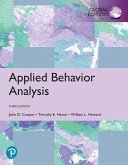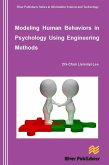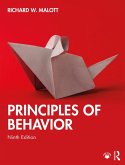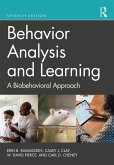Terrance M. Scott, Cynthia M. Anderson, Peter Alter
Managing Classroom Behavior Using Positive Behavior Supports (eBook, PDF)
Pearson New International Edition
37,95 €
37,95 €
inkl. MwSt.
Sofort per Download lieferbar

19 °P sammeln
37,95 €
Als Download kaufen

37,95 €
inkl. MwSt.
Sofort per Download lieferbar

19 °P sammeln
Jetzt verschenken
Alle Infos zum eBook verschenken
37,95 €
inkl. MwSt.
Sofort per Download lieferbar
Alle Infos zum eBook verschenken

19 °P sammeln
Terrance M. Scott, Cynthia M. Anderson, Peter Alter
Managing Classroom Behavior Using Positive Behavior Supports (eBook, PDF)
Pearson New International Edition
- Format: PDF
- Merkliste
- Auf die Merkliste
- Bewerten Bewerten
- Teilen
- Produkt teilen
- Produkterinnerung
- Produkterinnerung

Bitte loggen Sie sich zunächst in Ihr Kundenkonto ein oder registrieren Sie sich bei
bücher.de, um das eBook-Abo tolino select nutzen zu können.
Hier können Sie sich einloggen
Hier können Sie sich einloggen
Sie sind bereits eingeloggt. Klicken Sie auf 2. tolino select Abo, um fortzufahren.

Bitte loggen Sie sich zunächst in Ihr Kundenkonto ein oder registrieren Sie sich bei bücher.de, um das eBook-Abo tolino select nutzen zu können.
Managing Classroom Behavior Using Positive Behavior Supports
- Geräte: PC
- ohne Kopierschutz
- eBook Hilfe
Andere Kunden interessierten sich auch für
![Applied Behavior Analysis, Global Edition (eBook, PDF) Applied Behavior Analysis, Global Edition (eBook, PDF)]() John O. CooperApplied Behavior Analysis, Global Edition (eBook, PDF)37,95 €
John O. CooperApplied Behavior Analysis, Global Edition (eBook, PDF)37,95 €![Modeling Human Behaviors in Psychology Using Engineering Methods (eBook, PDF) Modeling Human Behaviors in Psychology Using Engineering Methods (eBook, PDF)]() Chi-Chun LeeModeling Human Behaviors in Psychology Using Engineering Methods (eBook, PDF)113,95 €
Chi-Chun LeeModeling Human Behaviors in Psychology Using Engineering Methods (eBook, PDF)113,95 €![Principles of Behavior (eBook, PDF) Principles of Behavior (eBook, PDF)]() Richard W. MalottPrinciples of Behavior (eBook, PDF)182,95 €
Richard W. MalottPrinciples of Behavior (eBook, PDF)182,95 €![Acceptance and Commitment Therapy for Behavior Analysts (eBook, PDF) Acceptance and Commitment Therapy for Behavior Analysts (eBook, PDF)]() Mark R. DixonAcceptance and Commitment Therapy for Behavior Analysts (eBook, PDF)47,95 €
Mark R. DixonAcceptance and Commitment Therapy for Behavior Analysts (eBook, PDF)47,95 €![Women in Behavior Science (eBook, PDF) Women in Behavior Science (eBook, PDF)]() Women in Behavior Science (eBook, PDF)47,95 €
Women in Behavior Science (eBook, PDF)47,95 €![Behavior Analysis and Learning (eBook, PDF) Behavior Analysis and Learning (eBook, PDF)]() Erin B. RasmussenBehavior Analysis and Learning (eBook, PDF)142,95 €
Erin B. RasmussenBehavior Analysis and Learning (eBook, PDF)142,95 €![Applied Behavior Science in Organizations (eBook, PDF) Applied Behavior Science in Organizations (eBook, PDF)]() Applied Behavior Science in Organizations (eBook, PDF)52,95 €
Applied Behavior Science in Organizations (eBook, PDF)52,95 €-
-
-
Managing Classroom Behavior Using Positive Behavior Supports
Dieser Download kann aus rechtlichen Gründen nur mit Rechnungsadresse in A, B, BG, CY, CZ, D, DK, EW, E, FIN, F, GR, HR, H, IRL, I, LT, L, LR, M, NL, PL, P, R, S, SLO, SK ausgeliefert werden.
Produktdetails
- Produktdetails
- Verlag: Pearson HigherEducation
- Seitenzahl: 270
- Altersempfehlung: ab 18 Jahre
- Erscheinungstermin: 3. Oktober 2013
- Englisch
- ISBN-13: 9781292055268
- Artikelnr.: 41940357
- Verlag: Pearson HigherEducation
- Seitenzahl: 270
- Altersempfehlung: ab 18 Jahre
- Erscheinungstermin: 3. Oktober 2013
- Englisch
- ISBN-13: 9781292055268
- Artikelnr.: 41940357
- Herstellerkennzeichnung Die Herstellerinformationen sind derzeit nicht verfügbar.
Chapter 1
Introduction to a Prevention-Focused Model of Behavior Support
Discipline Problems in the School
The “Causes” of Misbehavior
Summary
Proactive Management
Preventing Failure by Promoting Success
Prevention and the Academic-Social Behavior Connection
A Three-Tiered Approach to Proactive Management
Chapter Review
Chapter 4
Measuring Behavior in the School
Defining Behavior
Dimensions of Behavior
Measurement Process
Step 1: Determine What to Monitor
Step 2: Determine the Simplest Way to Collect Data
Step 3: Monitor Behavior in a Consistent Manner
Step 4: Use Data to Evaluate and Make Decisions
Behavior Monitoring Methods
Event-Based Recording
Time-Based Recording
Decision Model
Chapter Review
Chapter 5
Using Data to Make Instructional Decisions
Scope and Sequence: What Should Be Taught First, Second. . .?
Performing a Task Analysis: How Is It Done?
Goals and Objectives: Plans for Teaching and Evaluation
Educational Goal Statement
Instructional Objectives
Writing Instructional Objectives: Process
Evaluating Instruction
Graphing Behavior: Visual Representations of Performance
Evaluating Performance
Aim Lines
Trend Lines
Data-Based Decision Making
Determining Effectiveness of the Plan
Decisions: Successful Performance
Chapter Review
Chapter 6
A Function-Based Perspective of Classroom Management
Rationale for Assessing a Classroom
Matching the Intervention to the Classroom
Emphasizing Educative Behavior Management
Conducting a Functional Behavior Assessment of the Classroom
Focus on Functional Routines
Using a Scatter Plot to Identify Problematic Routines
Antecedents and Consequences
Antecedent Variables
Setting Events and Contextual Variables Affecting Behavior in the Classroom
Activities as Possible Setting Events
Discriminative Stimuli
Identifying Cues for Appropriate Behavior
Consequences
Consequences for Inappropriate Behavior
What Consequences Follow Problem Behavior?
Which Consequences Are Reinforcing the Behavior?
Consequences for Appropriate Behavior
Summary
Chapter Review
Appendix A–Functional Assessment for Classroom Environments Template
Appendix B–Functional Assessment for Classroom Environments Example
Chapter 7
Effective Instruction for Behavior
The Importance of Instruction
Instruction = Maximizing Success Rates
The Academic-Behavior Connection
Key Features of Effective Instruction
Effective Instruction for Behavior
Facilitating Instruction
Considerations
Chapter Review
Chapter 8
Antecedent Interventions in the Classroom
Changing Setting Events to Improve Student Behavior
Changing the Physical Layout of the Room
Defining and Teaching Expected Behavior
Structure of Routines
Supervision Style
Activities That Occur Before or After Class
Manipulating the Effects of Discriminative Stimuli
Summary
Chapter Review
Chapter 9
Using Consequences to Encoura
Introduction to a Prevention-Focused Model of Behavior Support
Discipline Problems in the School
The “Causes” of Misbehavior
Summary
Proactive Management
Preventing Failure by Promoting Success
Prevention and the Academic-Social Behavior Connection
A Three-Tiered Approach to Proactive Management
Chapter Review
Chapter 4
Measuring Behavior in the School
Defining Behavior
Dimensions of Behavior
Measurement Process
Step 1: Determine What to Monitor
Step 2: Determine the Simplest Way to Collect Data
Step 3: Monitor Behavior in a Consistent Manner
Step 4: Use Data to Evaluate and Make Decisions
Behavior Monitoring Methods
Event-Based Recording
Time-Based Recording
Decision Model
Chapter Review
Chapter 5
Using Data to Make Instructional Decisions
Scope and Sequence: What Should Be Taught First, Second. . .?
Performing a Task Analysis: How Is It Done?
Goals and Objectives: Plans for Teaching and Evaluation
Educational Goal Statement
Instructional Objectives
Writing Instructional Objectives: Process
Evaluating Instruction
Graphing Behavior: Visual Representations of Performance
Evaluating Performance
Aim Lines
Trend Lines
Data-Based Decision Making
Determining Effectiveness of the Plan
Decisions: Successful Performance
Chapter Review
Chapter 6
A Function-Based Perspective of Classroom Management
Rationale for Assessing a Classroom
Matching the Intervention to the Classroom
Emphasizing Educative Behavior Management
Conducting a Functional Behavior Assessment of the Classroom
Focus on Functional Routines
Using a Scatter Plot to Identify Problematic Routines
Antecedents and Consequences
Antecedent Variables
Setting Events and Contextual Variables Affecting Behavior in the Classroom
Activities as Possible Setting Events
Discriminative Stimuli
Identifying Cues for Appropriate Behavior
Consequences
Consequences for Inappropriate Behavior
What Consequences Follow Problem Behavior?
Which Consequences Are Reinforcing the Behavior?
Consequences for Appropriate Behavior
Summary
Chapter Review
Appendix A–Functional Assessment for Classroom Environments Template
Appendix B–Functional Assessment for Classroom Environments Example
Chapter 7
Effective Instruction for Behavior
The Importance of Instruction
Instruction = Maximizing Success Rates
The Academic-Behavior Connection
Key Features of Effective Instruction
Effective Instruction for Behavior
Facilitating Instruction
Considerations
Chapter Review
Chapter 8
Antecedent Interventions in the Classroom
Changing Setting Events to Improve Student Behavior
Changing the Physical Layout of the Room
Defining and Teaching Expected Behavior
Structure of Routines
Supervision Style
Activities That Occur Before or After Class
Manipulating the Effects of Discriminative Stimuli
Summary
Chapter Review
Chapter 9
Using Consequences to Encoura
Chapter 1
Introduction to a Prevention-Focused Model of Behavior Support
Discipline Problems in the School
The “Causes” of Misbehavior
Summary
Proactive Management
Preventing Failure by Promoting Success
Prevention and the Academic-Social Behavior Connection
A Three-Tiered Approach to Proactive Management
Chapter Review
Chapter 4
Measuring Behavior in the School
Defining Behavior
Dimensions of Behavior
Measurement Process
Step 1: Determine What to Monitor
Step 2: Determine the Simplest Way to Collect Data
Step 3: Monitor Behavior in a Consistent Manner
Step 4: Use Data to Evaluate and Make Decisions
Behavior Monitoring Methods
Event-Based Recording
Time-Based Recording
Decision Model
Chapter Review
Chapter 5
Using Data to Make Instructional Decisions
Scope and Sequence: What Should Be Taught First, Second. . .?
Performing a Task Analysis: How Is It Done?
Goals and Objectives: Plans for Teaching and Evaluation
Educational Goal Statement
Instructional Objectives
Writing Instructional Objectives: Process
Evaluating Instruction
Graphing Behavior: Visual Representations of Performance
Evaluating Performance
Aim Lines
Trend Lines
Data-Based Decision Making
Determining Effectiveness of the Plan
Decisions: Successful Performance
Chapter Review
Chapter 6
A Function-Based Perspective of Classroom Management
Rationale for Assessing a Classroom
Matching the Intervention to the Classroom
Emphasizing Educative Behavior Management
Conducting a Functional Behavior Assessment of the Classroom
Focus on Functional Routines
Using a Scatter Plot to Identify Problematic Routines
Antecedents and Consequences
Antecedent Variables
Setting Events and Contextual Variables Affecting Behavior in the Classroom
Activities as Possible Setting Events
Discriminative Stimuli
Identifying Cues for Appropriate Behavior
Consequences
Consequences for Inappropriate Behavior
What Consequences Follow Problem Behavior?
Which Consequences Are Reinforcing the Behavior?
Consequences for Appropriate Behavior
Summary
Chapter Review
Appendix A–Functional Assessment for Classroom Environments Template
Appendix B–Functional Assessment for Classroom Environments Example
Chapter 7
Effective Instruction for Behavior
The Importance of Instruction
Instruction = Maximizing Success Rates
The Academic-Behavior Connection
Key Features of Effective Instruction
Effective Instruction for Behavior
Facilitating Instruction
Considerations
Chapter Review
Chapter 8
Antecedent Interventions in the Classroom
Changing Setting Events to Improve Student Behavior
Changing the Physical Layout of the Room
Defining and Teaching Expected Behavior
Structure of Routines
Supervision Style
Activities That Occur Before or After Class
Manipulating the Effects of Discriminative Stimuli
Summary
Chapter Review
Chapter 9
Using Consequences to Encoura
Introduction to a Prevention-Focused Model of Behavior Support
Discipline Problems in the School
The “Causes” of Misbehavior
Summary
Proactive Management
Preventing Failure by Promoting Success
Prevention and the Academic-Social Behavior Connection
A Three-Tiered Approach to Proactive Management
Chapter Review
Chapter 4
Measuring Behavior in the School
Defining Behavior
Dimensions of Behavior
Measurement Process
Step 1: Determine What to Monitor
Step 2: Determine the Simplest Way to Collect Data
Step 3: Monitor Behavior in a Consistent Manner
Step 4: Use Data to Evaluate and Make Decisions
Behavior Monitoring Methods
Event-Based Recording
Time-Based Recording
Decision Model
Chapter Review
Chapter 5
Using Data to Make Instructional Decisions
Scope and Sequence: What Should Be Taught First, Second. . .?
Performing a Task Analysis: How Is It Done?
Goals and Objectives: Plans for Teaching and Evaluation
Educational Goal Statement
Instructional Objectives
Writing Instructional Objectives: Process
Evaluating Instruction
Graphing Behavior: Visual Representations of Performance
Evaluating Performance
Aim Lines
Trend Lines
Data-Based Decision Making
Determining Effectiveness of the Plan
Decisions: Successful Performance
Chapter Review
Chapter 6
A Function-Based Perspective of Classroom Management
Rationale for Assessing a Classroom
Matching the Intervention to the Classroom
Emphasizing Educative Behavior Management
Conducting a Functional Behavior Assessment of the Classroom
Focus on Functional Routines
Using a Scatter Plot to Identify Problematic Routines
Antecedents and Consequences
Antecedent Variables
Setting Events and Contextual Variables Affecting Behavior in the Classroom
Activities as Possible Setting Events
Discriminative Stimuli
Identifying Cues for Appropriate Behavior
Consequences
Consequences for Inappropriate Behavior
What Consequences Follow Problem Behavior?
Which Consequences Are Reinforcing the Behavior?
Consequences for Appropriate Behavior
Summary
Chapter Review
Appendix A–Functional Assessment for Classroom Environments Template
Appendix B–Functional Assessment for Classroom Environments Example
Chapter 7
Effective Instruction for Behavior
The Importance of Instruction
Instruction = Maximizing Success Rates
The Academic-Behavior Connection
Key Features of Effective Instruction
Effective Instruction for Behavior
Facilitating Instruction
Considerations
Chapter Review
Chapter 8
Antecedent Interventions in the Classroom
Changing Setting Events to Improve Student Behavior
Changing the Physical Layout of the Room
Defining and Teaching Expected Behavior
Structure of Routines
Supervision Style
Activities That Occur Before or After Class
Manipulating the Effects of Discriminative Stimuli
Summary
Chapter Review
Chapter 9
Using Consequences to Encoura







